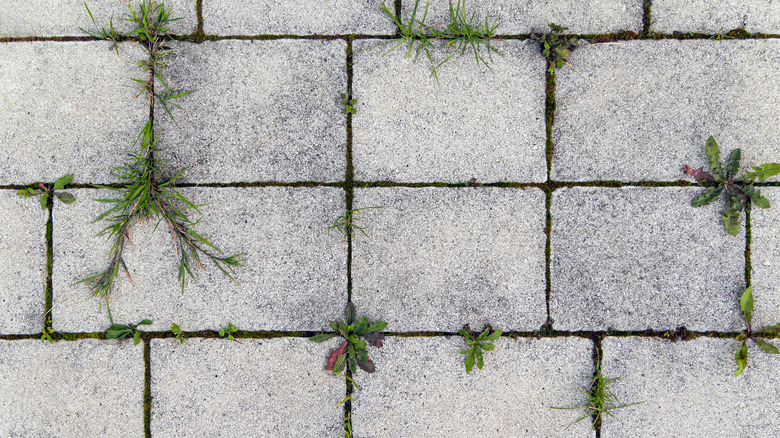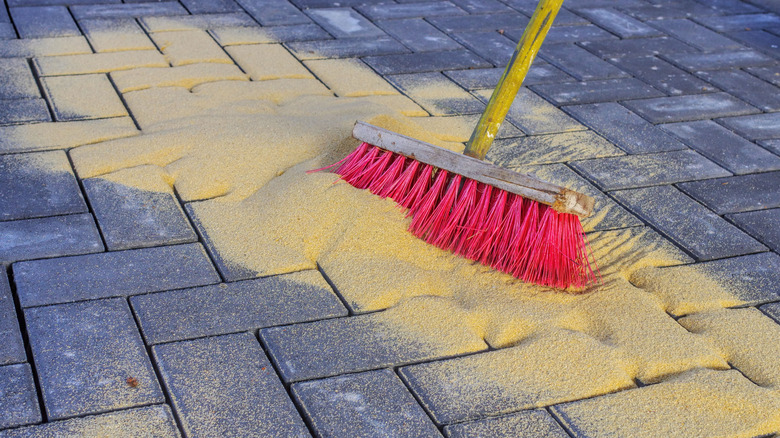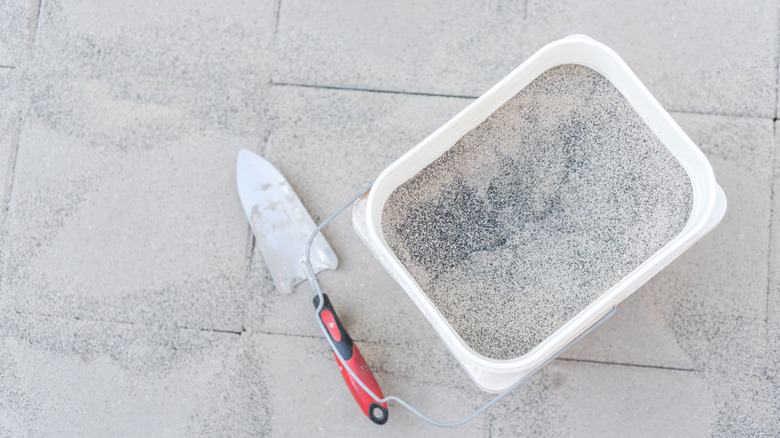Say Goodbye To Weeds Growing Between Pavers And Cracks With One Simple Fix
Whether it's a driveway, a walkway, or a patio, pavers make any outdoor space look more polished. In many cases, having pavers in your landscape can increase your home's value, too. But there is one frustration that comes with pavers — the weeds that grow in the cracks between the individual stones. Some amount of weed growth is almost inevitable because it's easy for weed seeds to blow into the gaps between the pavers, where they receive plenty of moisture and sunlight to grow. However, that doesn't mean you're doomed to a weed-filled driveway or patio. Adding polymeric sand to the cracks between your pavers is a straightforward, user-friendly way to help keep the weeds at bay as well as provide other benefits for the surface.
Polymeric sand contains a blend of fine masonry silica sand and polymers. These polymers are water-activated and help bind the individual particles of sand when wet. Adding polymeric sand to paver joints enhances the layout's stability and durability because it doesn't erode as easily as traditional paver sand. It can also help prevent ants and other insects from penetrating your paver surface. But its most popular benefit may be its ability to keep weeds from growing in the cracks between pavers, allowing the surface to look as neat and pristine as the day it was laid.
How to apply polymeric sand to pavers
Before applying polymeric sand, use a few smart weed removal hacks to eliminate any growth from the cracks between your pavers. Pulling plants by hand might not be enough, because the roots may remain intact. Treat the gaps with a quality weed killer to ensure they are completely gone. Check the size of the gaps you're filling, as polymeric sand often works best with gaps between ¼ and 1 ½ inches. If you have larger gaps, some advanced polymeric sand formulas can work in spaces several inches wide. Next, choose the right day to apply the sand. You want approximately 24 rain-free hours before the installation to ensure that the pavers are fully dry.
When you're ready to apply, pour the polymeric sand over your pavers, and sweep it into the cracks with a broom. To compress the sand, tap the pavers with a hand tamper or, for convenience, the end of the broom. Push more sand into the cracks until it sits approximately ⅛ inch from the top of the pavers, and sweep the excess from the surface.
Watering the polymeric sand properly is the final but most important step. Use a spray nozzle to mist the pavers gently. Watch closely to see if the sand-filled joints continue to absorb water. Once they no longer soak up the water, stop spraying. Keep people from walking on the surface for 24 hours or cars from driving on it for 72 hours to give the sand time to set fully.
Avoid mistakes when using polymeric sand on your pavers
Among the many tricks to prevent weeds from growing between your pavers, polymeric sand offers unique benefits when done right. Because polymeric sand hardens after it is treated with water, it forms a solid, almost cement-like seal that keeps the pavers in place. It easily fills all the gaps between the individual pavers, giving weeds nowhere to take root. It won't wash away in rain or other inclement weather like traditional sand either, so it is a great long-term weed prevention solution.
However, while polymeric sand can help make your pavers weed-resistant, it can't completely weed-proof your surface. You may see a few stray weeds pop up in the cracks between your pavers if you make mistakes when using the sand. Applying polymeric sand to wet or damp pavers could cause it to activate too soon and prevent it from setting as it should, which can allow weeds to poke their way through. If you apply too little water to the sand, it might not set all the way from top to bottom either, so the joint won't stay sealed and will collapse over time. However, applying too much water also causes issues by separating the polymers and the sand particles and creating a weaker joint that weeds can grow through. You may also find some weeds in your pavers if you don't push the sand deep enough into the cracks between them.


